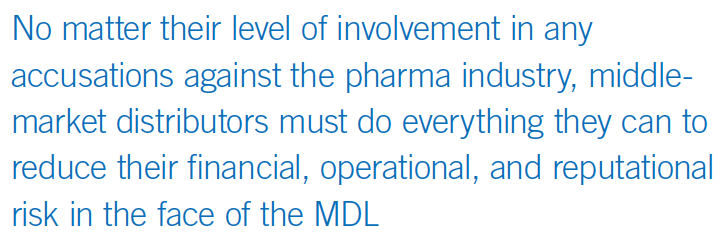Opioid Litigation: Evading the Widening Crosshairs
Pharmaceutical Executive
The role of insurance and risk management in protecting middle-market distributors from the growing opioid multi-district litigation (MDL).
A massive multi-district litigation (MDL) filed against pharmaceutical companies engaged in the production, marketing, and distribution of prescription painkillers is raising questions about insurance liability and who will ultimately be held responsible for the nationwide opioid epidemic.
Plaintiffs in the lawsuit are alleging that the manufacturers of prescription opioids “grossly misrepresented the risks of long-term use of those drugs for persons with chronic pain.” Distributors are also alleged to have “failed to properly monitor suspicious orders of those prescription drugs-all of which contributed to the current opioid epidemic” taking the lives of about 115 Americans per day.
What started as a lawsuit aimed at the largest manufacturers in opioids has expanded to include companies involved in nearly every stage of the supply chain, and middle-market distributors are far from immune. The MDL has ballooned to include hundreds of individual cases and dozens of defendants so far. Two lawyers I spoke to described the attorneys representing the municipalities, hospitals, third-party payers, union benefit plans, and Native American tribes named as plaintiffs in the MDL as “carpet-bombing” the industry by roping in as many companies as they can.
Many of the large pharmaceutical manufacturers and distributors named as defendants in the litigation were initially involved due to their marketing of branded opioid products. Most middle-market firms had no role in the marketing excesses alleged by the plaintiffs, but this hasn’t stopped plaintiffs from naming them in complaints.
Presiding Judge Dan Polster is seen by many as a social reformer who will use this case to take meaningful strides in the mitigation of the opioid epidemic. Many believe Polster is pushing to resolve this issue with a settlement that could leave the industry on the hook for billions of dollars in restitution and legal expenses.
Whether or not middle market distributors contributed to the widespread use of opioids, these companies are subject to the significant legal costs, business interruptions, and reputational damage that come with being named in the MDL. Making matters worse is that many of these companies may be more exposed than they previously thought.
Understanding the insurance market’s response
Part of what makes this MDL unique is that most of the cases are not general liability cases that focus on bodily injury or property damage that typically trigger an insurance policy. Rather, plaintiffs are arguing it was intentionally malicious and deceitful behavior that led to the financial burden imposed on the local municipalities that have been left to pick up the pieces today. As a result, many of the claims made in these cases do not include specific allegations that would trigger general liability policies and force insurers to address subsequent legal costs. In fact, I spoke with one lawyer representing several middle-market opioid distributors in the MDL who told me they are yet to see a single insurance policy be triggered as a result of this lawsuit.
One underwriter told me that insurers do not want to be “walking into a burning building.” Rather than leaving any room for policy language debate, some carriers have taken immediate, decisive action to insert outright exclusions for opioids and governmental actions into their policies. Others are attempting to exclude allegations involving opioid addiction, but may distinguish addiction and associated marketing actions, leaving the door open for claims resulting from design or manufacturing defects. Finally, some carriers are making distinctions to pare coverage back as it pertains to specific opioid exposures, including clinical trials, animal products, and newer products used exclusively in hospital settings. There is also a product identification issue for newer distributors that may be roped into the MDL despite having no involvement in the initial alleged marketing excesses of the branded opioid products that are at the center of this mass tort. This predicament could force an insurer to rely on a summary judgement to extract the distributor from the lawsuit, which puts insurers in a difficult position.
While reinsurance affordability and availability have also made underwriting this risk more challenging, some insurers are still willing to consider it in some cases. However, securing a policy that meets the risk tolerance needs of the insurer while providing adequate coverage for the distributor will require additional negotiations and a more meticulous eye when reviewing the policy on behalf of both parties.
How distributors can still protect themselves
This new insurance environment places companies in a tough spot. Insurers are examining their general liability policies very closely to protect themselves from any unnecessary exposure, and the policyholders must do the same by working with their brokers to understand how their coverage may be affected.
Distributors should also consider a number of risk management actions to reduce their liability. They can start by reviewing their legal and regulatory obligations as it pertains to their oversight of opioid orders. The Controlled Substances Act mandates that all DEA-registered entities distributing opioids must “design and operate a system to disclose ... suspicious orders of controlled substances.” It is imperative that distributors be able to demonstrate and justify the efficacy of their order monitoring systems to prove they’ve fulfilled this obligation-which may require upgrading or updating their reporting mechanisms.
Conducting and documenting a contractual review of relationships with manufacturers, doctors, and pharmacies to ensure that responsible prescription and distribution practices are maintained is prudent. Manufacturers, distributors, and other third-party contractors are also held responsible for varying levels of oversight depending on their agreements with each other and pharmacies and doctor networks. Any opioid distributor with exposure in the current legal environment must take a close look at these documents to identify these obligations and ensure they are being fulfilled. These agreements also tend to contain indemnification provisions that are worth a close review as they have the potential to clarify and/or transfer a company’s culpability to someone with the greatest responsibility for the product while increasing their likelihood of securing an insurance policy.
Finally, distributors should take proactive measures to address the public opinion concerns surrounding opioid abuse. The MDL only serves to reinforce the public’s perception that the pharma industry is to blame for the opioid epidemic. Community outreach campaigns, partnerships with local advocacy groups, and communications programs aimed at educating doctor networks and pharmacies on the dangers of opioid use can align an organization as being part of the solution, as opposed to the problem.
A new normal
No matter their level of involvement in any accusations against the pharma industry, middle-market distributors must do everything they can to reduce their financial, operational, and reputational risk in the face of the MDL. While the current focus of the plaintiff’s bar may rest with the costs of abuse to municipalities, in time they may

focus on individuals injured by such exposure or addiction to opioids. At that time, companies manufacturing or distributing pain medications and their insurance carriers may be in the bullseye. As such, review of new allegations and careful reports of such circumstances to your product liability insurer may preserve liability coverage should a distributor become aware of specific injuries from such pain medications to patients.
This litigation could usher in a new normal in opioid manufacturing and distribution. That new normal could mean opioid manufacturers and distributors must comply with new regulations and practices to ensure effective marketing, communication, and safety practices are in place. A settlement could further impose such new standards and limits on business operations, resulting in additional requirements by distributors to take further preventive measures to ensure the safe distribution and consumption of these powerful drugs. By taking the right risk management steps and understanding the important role of insurance, companies can be better prepared to navigate impending litigation.
Dan Brettler is Life Science Practice Leader at Conner Strong & Buckelew

MDMA Therapy for Mental Health Conditions: Do the Benefits Outweigh the Risks?
October 25th 2024Despite a recent FDA Complete Response Letter issued to Lykos for midomafetamine capsules for the treatment of post-traumatic stress disorder, experts believe that the future is bright for psychedelic drugs that treat mental health conditions.
Securities Litigation Arising from Alzheimer's Drug Treatments
September 25th 2024The legal challenges surrounding Biogen’s Aduhelm and Cassava Sciences’ simufilam underscore the ongoing difficulties in Alzheimer's drug development, leading to securities litigation over allegedly misleading statements about trial results and commercialization efforts.